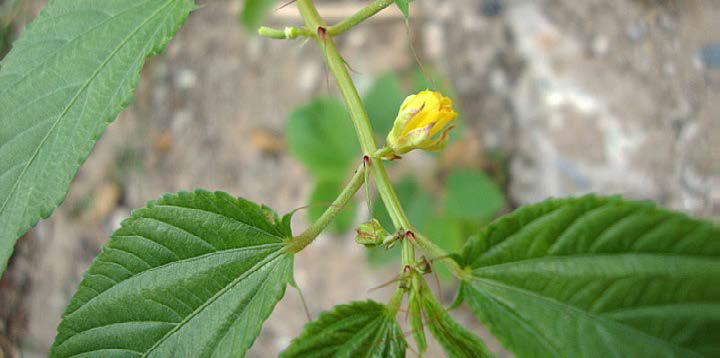Lerotho, Bangala, Spider flower, Delele, Jew’s mallow and kale are all part of the African leafy vegetables that can be commercially grown. These plants also help fight against malnutrition as they are rich in many minerals and vitamins.
We will be discussing these leafy greens as a group since the cultivation method is similar.
The popularity of these veggies are due to the speed at which they mature, and how easily a household can grow it in their home gardens or vegetable patch. It is well-suited as an intercrop or, if planted in a rotational system with other plants, a multicrop.
One of the African leafy vegetabels that is frequently cultivated is marogo or imfino. It is often enjoyed with stiff porridge. Like other leafy greens, it is rich in vitamins and minerals, especially vitamin A and iron.

Brassica carinata (Source: Habesha Gomen via Wikicommons)
Other kinds of leafy vegetables include:
- Amaranthus species (Amaranths, pigweed, marogo)
- Cleome gynandra (Spider plant)
- Corchorus spp (Gushe)
- Brasica carinata (Kale)
- Solanum retroflexum (Nightshade)
- Colocasia esculenta (Amadumbe)
Climatic and soil requirements
African leafy vegetables fare best in climates where temperatures are usually between 15 and 30 °C, but each species differs. Some, such as Cleome and Corchorus, prefer warm day temperatures, and are sensitive to cold. Cleome requires full sun.
The vegetables grow well in sandy to loam soil. One of the reasons that African leafy vegetables are regarded as good crops and effective in fighting malnutrition, is that it fares well in a wide variety of soil types. It is however a good rule not to plant it in soil that gets waterlogged, as this can cause rootrot.

Colocasia esculenta (Source: Wikicommons)
Uses
Depending on the particular vegetable and the personal preference of the person preparing the food, these leaves are prepared in the same ways as spinach.
Soil preparation
Prepare a fine seedbed. You can use a fork or rake to break any clods. A shovel can also be used. Take note of the fertilisation requirements the plants before planting.
Make shallow furrows in the soil bed, between 1,5 and 2,5 cm deep, and 25 to 35 cm apart.
Planting
Start by mixing the seed with some soil and sow evenly in the furrows. Irrigate lightly after sowing. Bigger seeds can be sown directly into the furrows,
Thin plants out when seedlings are 15 cm tall. Ensure there is 10 to 15 cm between plants. Note that the germination of spider flower could be uneven. Corchorus seed also needs to be broken before sowing or it will remain dormant. When it comes to intercropping, most of the African leafy vegetables can be intercropped with one other or with maize.

Solanum retroflexum (Source: Wikicommons)
Fertilisation
When preparing the seedbed, use ripened manure and thoroughly work it into the seedbed. Use approximately 3 kg of manure per square metre of soil bed.
If you are using chicken manure, use half of the measurement (1,5 kg per square meter). Use manure with high levels of nitrogen to delay flowering and increase the leaf yield. You can also add 100 gram of ash per square metre of soil when planting corchorus. Give the manure chance to break down before you plant.
Irrigation
African leafy vegetables need water two or three times a week, depending on the temperature and rainfall. Heat stress and drought will cause plants to develop quicker through different stages. Effectively the plant jumps to developing flowers, and thus seed, quickly skipping past growing, affecting the amount that is harvested. If day temperatures are extremely high, water daily.

Gynandropsis gynandra (Source: Robert Blittersdorf via Feedpedia)
Irrigate in the early mornings and late evening to ensure the water does not evaporate during the hot days.
Harvesting
When harvesting, there are three options: uprooting, cutting back (± 15 to 20 cm) or picking the leaves. Plants that are growing healthy and lavishly can be harvested often.
The best time to harvest is during the early mornings or late evenings. Once plants are growing well, frequent harvesting of leaves or shoots can take place.
If plants are uprooted place them in water. If shoots and leaves are harvested wrap them in a wet cloth, or in a well-ventilated bag over night. Avoid excessive water as this will cause rot. You can dip the shoots in water for about 30 minutes to revive them again the next morning.

Citrullus ecirrhosus (Source: Roger Culos via Wikicommons)
Pest and disease control
There are a few pests that attack African leafy vegetables. Here are some examples:
Cleome: Flea beetle, nematodes, stem borer, pod borers and cutworms.
Kale: Aphids, mosaic virus, diamond back moth.
All of these pests and any viruses can be controlled by using registered chemicals to control them. Additionally, strict sanitation practices during the growing season should be practiced. You can monitor crops for important pests and diseases and prevent them before they cause serious damage.

Amaranthus palmeri (Source: Wikicommons).
The information provided in this article is credited to the Agricultural Research Council Vegetable and Ornamental Plant Institute (ARC-VOPI). For more information, contact +27(0)12-841-9611 or visit http://www.arc.agric.za.









